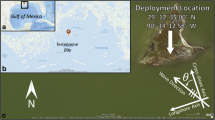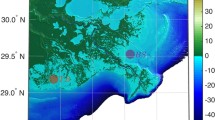Abstract
This paper presents laboratory experiments of wave-driven hydrodynamics in a three-dimensional laboratory model of constructed coastal wetlands. The simulated wetland plants were placed on the tops of conically-shaped mounds, such that the laboratory model was dynamically similar to marsh mounds constructed in Dalehite Cove in Galveston Bay, Texas. Three marsh mounds were placed in the three-dimensional wave basin of the Haynes Coastal Engineering Laboratory at Texas A&M University, with the center of the central wetland mound located in the center of the tank along a plane of symmetry in the alongshore direction. The experiments included two water depths, corresponding to emergent and submerged vegetation, and four wave conditions, typical of wind-driven waves and ocean swell. The wave conditions were designed so that the waves would break on the offshore slope of the wetland mounds, sending a strong swash current through the vegetated patches. Three different spacings between the wetland mounds were tested. To understand the effects of vegetation, all experiments were repeated with and without simulated plants. Measurements were made throughout the nearshore region surrounding the wetland mounds using a dense array of acoustic Doppler velocimeters and capacitance wave gauges. These data were analyzed to quantify the significant wave height, phase average wave field and phase lags, wave energy dissipation over the vegetated patches, mean surface water levels, and the near-bottom current field. The significant wave height and energy dissipation results demonstrated that the bathymetry is the dominant mechanism for wave attenuation for this design. The presence of plants primarily increases the rate of wave attenuation through the vegetation and causes a blockage effect on flow through the vegetation. The nearshore circulation is most evident in the water level and velocity data. In the narrowest mound spacing, flow is obstructed in the channel between mounds by the mound slope and forced over the wetlands. The close mound spacing also retains water in the nearshore, resulting in a large setup and lower flows through the channel. As the spacing increases, flow is less obstructed in the channel. This allows for more refraction of waves off the mounds and deflection of flow around the plant patches, yielding higher recirculating flow through the channel between mounds. An optimal balance of unobstructed flow in the channel, wave dissipation over the mounds, and modest setup in the nearshore results when the edge-to-edge plant spacing is equal to the mound base diameter.














Similar content being viewed by others
References
Asano T (2006) Wave attenuation and sediment deposition due to coastal vegetation. J Glob Environ Eng 11:29–44
Asano T, Matsumoto S, Kikuchu S (2005) Wave deformation in vegetation fringed channels. In: Proceedings of the 29th international conference on coastal engineering, Lisbon, vol. 1, pp 218–229.
Augustin LN, Irish JL, Lynett P (2009) Laboratory and numerical studies of wave damping by emergent and near-emergent wetland vegetation. Coast Eng 56:332–340
Dalrymple RA, Kirby JT, Hwang PA (1984) Wave diffraction due to areas of energy dissipation. J Wtrwy Port Coast Oc Engrg 110(1):67–79
D’Errico J (2004) inpaint nans.m: Interpolate NaN elements in a 2D array using non-NaN elements. MATLAB Central File Exchange. http://www.mathworks.com/matlabcentral/fileexchange/4551 Accessed 19 April 2011
Dean GD, Dalrymple RA (1984) Water wave mechanics for engineers and scientists. World Scientific, Singapore
Folkard AM (2005) Hydrodynamics of model Posidonia Oceanica patches in shallow water. Limnol Oceanogr 50(5):1592–1600
Goring D, Nikora V (2002) Despiking acoustic Doppler velocimeter data. J Hydraul Eng 128(1):117–126
LaSalle MW, Landin MC, Sims JG (1991) Evaluation of the flora and fauna of a Spartina Alterniflora marsh established on dredged material in Winyah Bay, South Carolina. Wetlands 11(2):191–208
Loder NM, Irish JL, Cialone MA, Wamsley TV (2009) Sensitivity of hurricane surge to morphological parameters of coastal wetlands. Estuar Coast Shelf S 84:625–636
Mendez FJ, Losada IJ (2004) An empirical model to estimate the propagation of random breaking and nonbreaking waves over vegetation fields. Coast Eng 51:103–118
Minello TJ (2000) Temporal development of salt marsh value for nekton and epifauna: utilization of dredged material marshes in Galveston Bay, Texas, USA. Wetl Ecol Manag 8:327–341
Minello TJ, Webb JW Jr (1997) Use of natural and created Spartina Alterniflora salt marshes by fishery species and other aquatic fauna in Galveston Bay, Texas, USA. Mar Ecol-Prog Ser 151:165–179
Mori N (2006) Despike package: 3D phase-space method. MACE Toolbox for Coastal Engineers. http://www.oceanwave.jp/softwares/mace/index.php?MACE%20Softwares. Accessed 5 Nov 2010
Mori N, Suzuki T, Kakuno S (2007) Noise of acoustic Doppler velocimeter data in bubbly flow. J Eng Mech-ASCE 133(1):122–125
Nepf HM (1999) Drag, turbulence, and diffusion in flow through emergent vegetation. Water Resour Res 35(2):479–489
Nepf HM (2004) Vegetated flow dynamics. In: Fagherazzi S, Marani M, Blum LK (eds) The ecogeomorphology of tidal marshes. American Geophysical Union, Washington D.C., pp 137–163
Noarayanan L, Murali K, Sundar V (2012) Performance of flexible emergent vegetation in staggered configuration as a mitigation measure for extreme coastal disasters. Nat Hazards 62:531–550
Ravens TM, Thomas RC, Roberts KA, Santschi PH (2009) Causes of salt marsh erosion in Galveston Bay, Texas. J Coast Res 25(2):265–272
Shafer DJ, Streever WJ (2000) A comparison of 28 natural and dredged material salt marshes in Texas with an emphasis on geomorphological variables. Wetl Ecol Manag 8:353–366
Shafer DJ, Roland R, Douglass SL (2003) Preliminary evaluation of critical wave energy thresholds at natural and created coastal wetlands. WRP Technical Notes Collection (ERDC TN- WRP-HS-CP-2.2). Vicksburg, Mississippi: U.S. Army Engineer Research and Development Center. http://el.erdc.usace.army.mil/elpubs/pdf/hscp2-2. Accessed 25 June 2012
Streever WJ (2000) Spartina Alterniflora marshes on dredged material: a critical review of the ongoing debate over success. Wetl Ecol Manag 8:295–316
Wamsley TV, Cialone MA, Smith JM, Atkinson JH, Rosati JD (2010) The potential of wetlands in reducing storm surge. Ocean Eng 37:59–68
White BL, Nepf HM (2007) Shear instability and coherent structures in shallow flow adjacent to a porous layer. J Fluid Mech 593:1–32
Yamagishi M, Togano T, Tashiro S (2007) Phase averaging analysis of the unsteady velocity profiles in the separation flow on the flat plate. J Environ Eng 2(4):667–680
Acknowledgments
Publication supported in part by an Institutional Grant (NA14OAR4170102) to the Texas Sea Grant College Program from the National Sea Grant Office, National Oceanic and Atmospheric Administration, U.S. Department of Commerce. In addition, the authors would like to thank Mr. John Reed and Dr. Po-H. Yeh for their technical guidance and the sharing of their experience in the Haynes Coastal Engineering Laboratory. Special thanks are also given to Mr. David Dailey and Ms. Kristie Drawe, student workers in the research group, and also Mr. Paul Ramsey, Mr. Christopher Ryan and Mr. Eric Sonne, student workers at the Haynes Laboratory, for their help and input during the laboratory experiments. All experimental data used in preparation of this paper are available from authors KAW or SAS.
Author information
Authors and Affiliations
Corresponding author
Rights and permissions
About this article
Cite this article
Truong, M.K., Whilden, K.A., Socolofsky, S.A. et al. Experimental study of wave dynamics in coastal wetlands. Environ Fluid Mech 15, 851–880 (2015). https://doi.org/10.1007/s10652-014-9384-x
Received:
Accepted:
Published:
Issue Date:
DOI: https://doi.org/10.1007/s10652-014-9384-x




